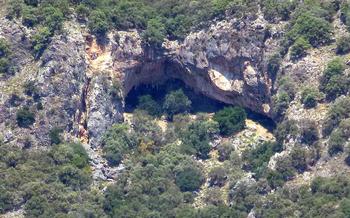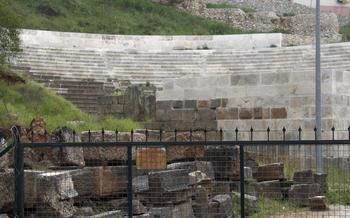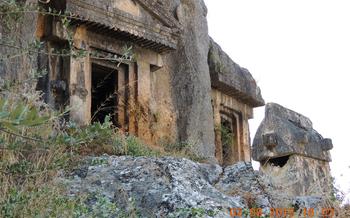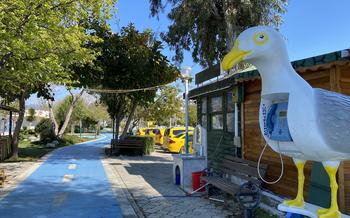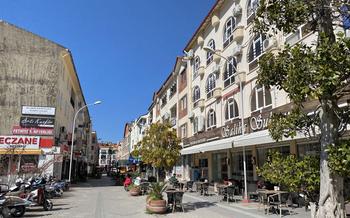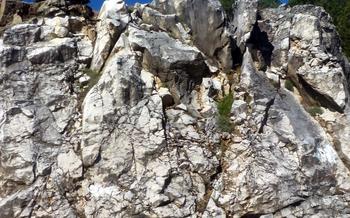
Araxa Ancient City
- Araxa Ancient City: A Journey Through Time
- Uncovering the Past: Exploring the Ruins
- A Stroll Through History: The Necropolis
- The Theater: A Stage for Ancient Performances
- The Agora: Marketplace and Social Hub
- The Temple of Apollo: A Place of Worship
- The City Walls: Guardians of Araxa
- Cisterns: Ancient Water Storage Systems
- Olive Oil Production: A Legacy of Araxa
- Local Cuisine: Flavors of Araxa
- Nearby Beaches: A Coastal Paradise
- Hiking Trails: Exploring the Natural Beauty
- Insider Tip: Best Time to Visit
Araxa Ancient City: A Journey Through Time
Historical Significance
Araxa Ancient City, nestled within the picturesque landscapes of the Turquoise Coast in Turkey, stands as a testament to the rich history and cultural heritage of the region. Once a thriving city-state of the Lycian League, Araxa played a pivotal role in ancient maritime trade and diplomacy. Its strategic location, coupled with its fertile agricultural hinterland, contributed to its prosperity and prominence in the region.
Location
Araxa Ancient City is situated in the stunning Fethiye district of Mugla province, boasting breathtaking views of the Mediterranean Sea and the surrounding mountains. This ancient gem lies approximately 20 kilometers southeast of Fethiye city center, making it an easily accessible destination for history enthusiasts and travelers seeking to immerse themselves in the wonders of the past.
Accessibility
Reaching Araxa Ancient City is a breeze, with several transportation options available. Visitors can embark on a scenic drive along the coastal road or take a leisurely bus ride from Fethiye. Once in the village of Derekoy, a short walk or a charming donkey ride will lead you to the gates of this ancient metropolis, where history comes alive amidst the tranquil ambiance of the Turkish countryside.
Uncovering the Past: Exploring the Ruins
As you step through the gates of the Araxa Ancient City, you'll be transported back in time, surrounded by the remnants of a once-thriving civilization. The city's well-preserved structures stand as testaments to the architectural prowess of its ancient inhabitants.
One of the most impressive structures within the ruins is the amphitheater, a grand theater capable of accommodating thousands of spectators. Carved into the hillside, the theater features tiers of stone seats that offer breathtaking views of the surrounding landscape. Imagine the excitement and energy that filled the air during ancient performances, as actors and musicians brought stories and legends to life.
In addition to the amphitheater, the city also boasts a number of tombs, each adorned with intricate carvings and inscriptions that tell stories of the lives and legacies of those buried within. These tombs offer a glimpse into the funerary practices and beliefs of the ancient Araxians.
Scattered throughout the ruins, you'll also discover a variety of artifacts, including pottery shards, coins, and tools, which provide valuable insights into the daily lives of the city's inhabitants. These artifacts paint a vivid picture of a bustling and prosperous community that engaged in trade, agriculture, and cultural exchange.
Exploring the ruins of Araxa Ancient City is an immersive experience that allows you to connect with the past and gain a deeper understanding of the rich history and culture of this ancient civilization.
A Stroll Through History: The Necropolis
The necropolis of Araxa is a captivating testament to the city's rich past and cultural traditions. Serving as the eternal resting place for its ancient inhabitants, this vast cemetery offers a glimpse into their beliefs, customs, and artistry.
The necropolis is adorned with an array of tombs, each possessing its own unique design and features. From simple graves to elaborate mausoleums, these structures showcase the diverse social and economic status of Araxa's citizens.
Intricate carvings and inscriptions embellish the tombs, providing valuable insights into the lives and achievements of those buried within. These inscriptions often include the names of the deceased, their lineage, and sometimes even their professions or accomplishments.
Strolling through the necropolis, visitors are treated to stunning views of the surrounding landscape. Perched on a hill overlooking the city, the cemetery offers panoramic vistas that encompass the ancient ruins, the turquoise waters of the Mediterranean Sea, and the distant peaks of the Taurus Mountains.
The Theater: A Stage for Ancient Performances
The theater in Araxa is a remarkable testament to the city's cultural and artistic heritage. Constructed in the Hellenistic period, it served as a venue for theatrical performances, musical concerts, and other entertainment events that brought the community together.
The theater's impressive architecture reflects the grandeur of the ancient city. Built into the natural slope of a hill, it features a well-preserved stage, orchestra pit, and seating area. The stage is adorned with intricate carvings and sculptures, hinting at the vibrant artistic traditions of Araxa.
With a seating capacity of over 1,000 spectators, the theater provided ample space for the local population to gather and enjoy performances. The acoustics of the theater are particularly noteworthy, with the natural amphitheater design ensuring that sound carries clearly throughout the space.
Beyond its cultural significance, the theater offers breathtaking views of the surrounding landscape. Perched on a hilltop, it commands panoramic vistas of the city, the sea, and the lush countryside. During performances, the audience would have been treated to a mesmerizing spectacle of nature and artistry.
The Agora: Marketplace and Social Hub
The agora, or marketplace, was a central gathering place for trade, social interactions, and public events in Araxa. Located in the heart of the city, it comprised an expansive courtyard surrounded by market stalls and shops where merchants sold a variety of goods, including agricultural produce, textiles, pottery, and jewelry. The agora also served as a meeting point for citizens to discuss civic matters, exchange news, and participate in public events such as festivals and religious ceremonies. This bustling center of commerce and community life played a vital role in the daily fabric of Araxa, connecting its inhabitants and facilitating the exchange of goods, ideas, and social interactions.
The Temple of Apollo: A Place of Worship
Religious Significance: In the heart of Araxa, the Temple of Apollo stood as a testament to the city's deep religious devotion. Apollo, the Greek god of music, poetry, healing, and prophecy, was highly revered in Araxa, and this temple served as a sacred place for his worship.
Architectural Style: The temple showcased an impressive blend of Greek and Roman architectural styles. Its grand entrance featured intricate carvings and columns, while the interior displayed a spacious layout designed to accommodate a large number of worshippers.
Remains of the Temple: Despite the passage of time and the ravages of history, substantial remains of the Temple of Apollo can still be seen today. The foundations, sections of walls, and architectural fragments provide valuable insights into the temple's original grandeur.
Connection to the God Apollo: Araxa's Temple of Apollo was more than just a place of worship; it was also a symbol of the city's deep connection to the god Apollo. The temple served as a sanctuary where people could seek guidance, healing, and inspiration from the divine.
The City Walls: Guardians of Araxa
Defensive Structures:
Araxa was surrounded by sturdy city walls that served as a formidable defense against potential invaders. These walls, meticulously constructed using large stone blocks, stood tall and protected the city from external threats. The strategic placement of gates and towers along the walls allowed for controlled access and provided additional security. The gates were reinforced with massive doors and guarded by soldiers to ensure the safety of the city's inhabitants.
Strategic Location:
The city walls were strategically positioned to take advantage of the natural terrain. Built on a hill overlooking the surrounding landscape, the walls provided a commanding view of the approaches to the city. This strategic location allowed the defenders to spot approaching enemies from a distance and prepare for their defense. The walls also served as a deterrent, discouraging potential attackers from attempting to breach the city's defenses.
Protection from Invaders:
The city walls proved to be an effective deterrent against invaders throughout Araxa's history. The sturdy construction and strategic placement of the walls made it difficult for enemies to penetrate the city's defenses. The walls withstood numerous attacks and sieges, protecting the city and its inhabitants from harm. They played a crucial role in ensuring the safety and security of Araxa, allowing it to flourish and prosper.
Cisterns: Ancient Water Storage Systems
The ancient city of Araxa was equipped with an impressive network of cisterns, showcasing the ingenuity and engineering prowess of its inhabitants. These underground reservoirs played a crucial role in ensuring a steady water supply for the city's population.
Built with meticulous precision, the cisterns were strategically located throughout Araxa, often beneath public buildings or private residences. Skilled craftsmen employed advanced construction techniques to create these subterranean chambers, utilizing stone, brick, and mortar to create durable and watertight structures.
The cisterns varied in size and capacity, with some capable of holding vast quantities of water. They were typically accessed through narrow openings or staircases, allowing for the collection and storage of rainwater or water diverted from nearby springs and rivers.
To ensure the purity and quality of the water, the cisterns were often lined with a layer of plaster or sealant, preventing contamination from soil or debris. Additionally, some cisterns were equipped with filtration systems, utilizing layers of sand, gravel, or charcoal to remove impurities.
The cisterns of Araxa not only provided a reliable source of water for domestic use but also played a vital role in supporting the city's agricultural activities. Farmers relied on the stored water to irrigate their crops, especially during periods of drought or when natural water sources were scarce.
These ancient cisterns stand as a testament to the foresight and ingenuity of the people of Araxa. Their advanced water management systems ensured the city's prosperity and resilience, allowing it to flourish even in challenging environmental conditions.
Olive Oil Production: A Legacy of Araxa
In Araxa, olive oil production has been a legacy passed down through generations, deeply intertwined with the city's history and culture. The surrounding fertile lands were home to vast olive groves, providing the raw material for this liquid gold. Farmers in Araxa have long relied on traditional methods of olive oil production, using techniques that have remained largely unchanged over the centuries.
The process begins with the careful harvesting of the olives, usually done by hand to ensure the utmost quality. Once picked, the olives are transported to local mills, where they are crushed and pressed to extract their precious oil. The resulting liquid is then filtered and stored in clay amphorae or other traditional containers.
A visit to Araxa offers a chance to witness this ancient craft firsthand. Visitors can explore the olive groves, learn about the harvesting and pressing techniques, and even sample the locally produced olive oil. The distinct flavor and aroma of this liquid gold are a testament to the skill and dedication of the local farmers.
Local Cuisine: Flavors of Araxa
A Culinary Journey Through History
Araxa's cuisine is a delightful blend of traditional Turkish flavors and fresh, local ingredients. The region is renowned for its seafood, with freshly caught fish and shellfish gracing the menus of many restaurants. Diners can indulge in grilled octopus, succulent shrimp, or savor the delicate flavors of sea bass cooked to perfection.
Beyond seafood, Araxa's cuisine showcases the bounty of the region's farms and orchards. Olive oil, a staple of Turkish cuisine, is produced locally using traditional methods, resulting in a rich and flavorful oil that enhances the taste of any dish. Visitors can also sample locally-grown fruits and vegetables, such as juicy tomatoes, sweet melons, and crisp cucumbers, which are often used in salads, mezes, and main courses.
Traditional Turkish Delights
No culinary exploration of Araxa is complete without trying some of the traditional Turkish dishes that are deeply ingrained in the local culture. One such dish is "meze," a selection of small plates that are served as appetizers or snacks. Meze typically includes hummus, baba ghanoush, stuffed grape leaves, and various dips and spreads, all of which are perfect for sharing and savoring with friends and family.
For a main course, visitors can indulge in "pide," a Turkish flatbread topped with various fillings such as minced lamb, cheese, or vegetables. Another popular dish is "köfte," grilled meatballs that are often served with rice or bulgur. And of course, no meal in Turkey is complete without "baklava," a sweet pastry made with layers of filo dough, nuts, and honey syrup.
Dining Experiences in Araxa
Araxa offers a range of dining experiences to suit every taste and budget. From casual eateries serving up fresh seafood and traditional Turkish fare to upscale restaurants with panoramic views of the Mediterranean Sea, there is something for everyone. Whether you prefer to dine al fresco on a warm summer evening or cozy up in a traditional Turkish tavern, Araxa's culinary scene will not disappoint.
Nearby Beaches: A Coastal Paradise
Araxa's proximity to the Mediterranean Sea grants visitors access to a string of captivating beaches, each offering unique experiences and breathtaking vistas. Calis Beach, located just 5 kilometers from Fethiye, enchants with its long stretch of golden sand, shallow waters, and array of water sports facilities, making it ideal for families and adventure seekers alike. Oludeniz Beach, renowned for its stunning turquoise lagoon and white-sand shores, beckons with its serene atmosphere and opportunities for swimming, sunbathing, and various water-based activities, including kayaking, paddleboarding, and jet skiing. For those seeking seclusion, Gemiler Island, a small island accessible by boat from Oludeniz, provides a tranquil haven with crystal-clear waters and secluded coves, inviting visitors to unwind amidst pristine natural beauty.
Hiking Trails: Exploring the Natural Beauty
Beyond the historical treasures of Araxa, nature enthusiasts will find solace in the scenic hiking trails that crisscross the region. Lace up your boots and embark on a journey through lush forests, where the air is perfumed with the scent of pine and the sound of birdsong fills the air.
The trails offer varying levels of difficulty, catering to both seasoned hikers and those seeking a leisurely stroll. As you ascend the slopes, you'll be rewarded with panoramic views of the surrounding landscape, where the azure waters of the Mediterranean Sea blend seamlessly with the verdant hues of the forests.
Take a break and soak in the tranquility of nature, listening to the gentle rustling of leaves and the distant sound of waves crashing against the shore. Capture the breathtaking views with your camera, or simply let the panorama wash over you, filling your soul with serenity.
Araxa's hiking trails are not just about physical exercise; they are an invitation to connect with the natural world and discover the hidden gems of this ancient city. Whether you prefer a challenging trek or a leisurely walk, you're sure to find rejuvenation and inspiration amidst the beauty of Araxa's natural surroundings.
Insider Tip: Best Time to Visit
For an optimal experience in Araxa, plan your visit during the shoulder seasons – spring (April-May) and autumn (September-October). During these months, the weather is at its best, with warm, sunny days and cool nights. The crowds are also smaller, allowing for a more tranquil and intimate exploration of the ancient city.
Additionally, the shoulder seasons often coincide with local festivals and events, providing an opportunity to immerse yourself in the vibrant culture and traditions of the region. These events showcase local cuisine, music, dance, and handicrafts, offering a glimpse into the daily life and heritage of the people of Araxa.
Whether you're a history buff, a nature lover, or simply seeking a relaxing getaway, visiting Araxa during the shoulder seasons offers a unique and rewarding experience.
